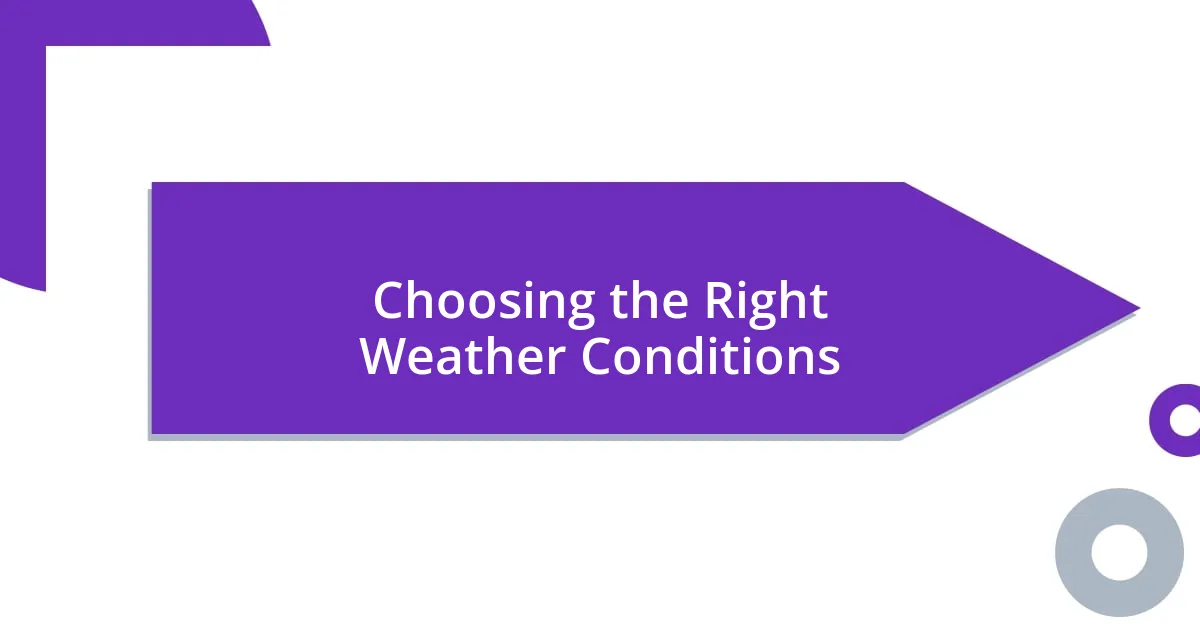Key takeaways:
- Choosing the right weather is crucial for photography; different conditions can dramatically alter the mood and quality of images.
- Understanding how light varies with weather conditions allows photographers to adjust their techniques and settings effectively.
- Adapting camera settings to suit weather conditions enhances image quality, with specific recommendations for overcast, sunny, foggy, rainy, snowy, and windy conditions.
- Post-processing techniques, such as adjusting contrast and color balance, can further enhance photos taken in varied weather conditions.

Choosing the Right Weather Conditions
Choosing the right weather conditions can make or break your shooting experience. I remember a rainy day when I thought I could capture some moody cityscapes, only to find my lens drenched and the atmosphere less enchanting than anticipated. Did I really think I could embrace the rain without protective gear? It’s moments like that when I learned the importance of preparation.
Consider your subject when deciding on the weather. For instance, I’ve found that golden hour during a crisp autumn morning offers a magical quality that bright, harsh sunlight just can’t replicate. Have you ever tried shooting during the blue hour, right before nightfall? The soft, ethereal light can transform even the most mundane scenes into something surreal.
Not all weather conditions are conducive to capturing stunning images. When I ventured out on a foggy morning, the world felt like a different place, cloaked in mystery. However, I soon realized that not every scene would translate well; some details can get lost in the haze. Have you ever experimented with fog? It’s a unique atmosphere, but it requires a mindful approach to your composition and focus.

Understanding Light in Various Weather
Understanding light in various weather conditions is crucial for capturing stunning images. I’ll never forget a day I was out shooting in overcast skies. Initially, I felt disappointed because the light seemed dull. But as I adjusted my perspective, I discovered this soft, diffused light was perfect for highlighting the intricate details of my subject without harsh shadows.
- Overcast days can produce even lighting, minimizing shadows and reducing glare, which is ideal for portraits or macro shots.
- Sunny days provide high contrast, which can be valuable for bold landscapes or vibrant colors but requires careful consideration of light direction.
- Fog not only creates a mysterious atmosphere but also softens the light, making colors appear richer and more vibrant.
- Rain can enhance local colors and add reflections, while also providing an opportunity for dramatic skies if you wait for the right moment.
It often takes experience to appreciate these shifts in light. One time, during a light drizzle, I found dynamic reflections on the pavement that added depth to my city shots, transforming a scene I might’ve otherwise overlooked. It was a wonderful reminder of how changing weather can give photography a fresh narrative.

Adapting Camera Settings for Weather
Adapting your camera settings to different weather conditions can be a transformative experience. For instance, when I faced a sudden downpour while hiking, I quickly switched my settings to a higher ISO to capture the dramatic raindrops in motion. It reminded me that sometimes, you have to embrace the unexpected and adjust your approach on the fly; being able to react creatively under pressure is what makes photography so exciting.
On a snowy day, I found myself facing the challenge of bright reflections from the snow. Lowering my exposure compensation helped tame the brightness, allowing the delicate details of the snow-laden branches to shine through. Each weather condition brings its unique challenges, but this isn’t just about technical settings; it’s about painting with light, where every adjustment tells a different story.
When shooting portraits during blustery conditions, I learned to set my shutter speed faster to freeze the motion of hair and clothing. Remember that weather isn’t just a backdrop; it can shape the mood of your frame. Have you ever tried capturing the anticipation in someone’s expression as they brace against a gust of wind? It adds a vibrant, dynamic element that you can only find when you’re willing to adapt.
| Weather Condition | Recommended Camera Settings |
|---|---|
| Overcast | Higher ISO, wider aperture for detail |
| Sunny | Lower ISO, faster shutter speed to handle exposure |
| Foggy | Increase contrast in post-processing, adjust white balance |
| Rainy | Higher shutter speed to capture movement, consider waterproof housing |
| Snowy | Lower exposure compensation, use a lens hood to reduce glare |
| Windy | Fast shutter speed to freeze motion, use stabilization features |

Techniques for Shooting in Rain
When I first ventured out into the rain with my camera, I quickly realized the magic of puddles reflecting vibrant colors. To make the most of these reflections, I learned to crouch low and shoot with a wide-angle lens to capture the full scene. The sense of wonder that comes from discovering new perspectives can turn an ordinary day into something extraordinary.
Using the rain to my advantage also meant adjusting my focus techniques. I often found myself embracing a slightly slower shutter speed to create a sense of movement in the falling droplets. There’s something profoundly poetic about capturing that dynamic flow; it makes the viewer feel the pulse of the rain. Have you ever paused to reflect on how that simple act can draw someone into the atmosphere of your photo?
Protecting my gear was another lesson learned in those rainy adventures. I invested in a quality rain cover after a few close calls with water splashes. It’s funny how a little preparation can save you a lot of heartache. Knowing that my camera was protected allowed me to focus entirely on capturing the fleeting beauty around me without worrying about damaging my equipment.

Capturing Unique Shots in Snow
Capturing unique shots in snow is like stepping into a different world. One winter day, as I wandered through a forest blanketed in white, I marveled at how the snow muffled sounds. I quickly adapted by lowering my exposure compensation, which allowed the soft textures of snow-covered trees to emerge from the brightness. Have you ever noticed how snow transforms familiar landscapes into something ethereal? It was a magical experience that reminded me to explore the subtleties of light and shadow.
On another occasion, I decided to experiment with the depth of field in snowy conditions. Using a wide aperture, I focused on a single snowflake resting on a branch, creating an intimate portrait that felt alive amid the vast winter scene. There’s something truly captivating about isolating details in snowy environments; it invites viewers to appreciate the beauty in small, often overlooked moments. What really struck me was how even the simplest subject, when framed thoughtfully, can resonate with emotion and intrigue.
And let’s not forget about movement. I remember a moment when I began to capture children joyfully playing in the snow, their laughter echoing through the cold air. Instead of frozen frames, I opted for a slightly slower shutter speed to capture the blur of their excitement. Watching their carefree spirits dance in the snow not only brought warmth to the icy day but also conveyed a narrative of joy that photographs sometimes fail to tell. What could be better than freezing those memories in time while showcasing their vibrancy? Each click was a reminder that snow is not just a barrier; it’s a palette for creativity.

Post-Processing Tips for Weather Effects
When processing photos taken in different weather conditions, I find that adjusting contrast and clarity can enhance the mood dramatically. For instance, during a foggy shoot, I love to decrease clarity a bit to give a soft, dreamy feel, almost like stepping into a memory. Have you ever felt the atmosphere shift in your images simply by fine-tuning these settings?
I also pay close attention to color balance, especially in snowy scenes. One time, after shooting a winter landscape, I found that adding a slight blue tint to the shadows not only brought out the serenity of the snow but also emphasized the crisp air. It’s surprising how such subtle changes can evoke a powerful sense of place—like you can almost feel the chill in the air again. Isn’t it fascinating how color can transport us back to that moment?
Lastly, I recommend using selective editing tools to accentuate specific weather effects. I often apply a subtle vignette when I capture a rainy street, highlighting the glowing reflections and drawing the viewer’s eye toward the center of the frame. This technique not only creates depth but also adds focus to the beauty found in rainy conditions. Have you tried enhancing your images this way? It might just change the way you present your favorite shots.












